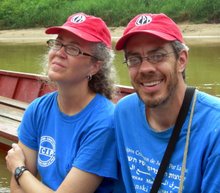Greetings Friends and Family,
After spending two months on vacation and giving presentations about Colombia in Minneapolis, we are writing once again from Barrancabermeja, Colombia. We returned to Barrancabermeja in September and we are excited to be spending another year here working with Christian Peacemaker Teams. (Your memory does serve you correctly if you thought we would only be here another 6 months – we made the decision over the summer to return for another year.)
We arrived to the news that the Colombian Army had begun a campaign of forced recruitment of young men to serve in the Army. Men are required to serve one year in the armed services unless they meet various conditions including being a student or caring for elderly parents. Legally, the Colombian Army can notify a young man that he is not in compliance with the law and order him to appear for his service. Instead, the Army has been driving around neighborhoods in a truck conducting sweeps, stopping every young man in sight and hauling him into the army base if he is not carrying a card verifying his military service.
One afternoon our teammate Pierre was walking when he saw two soldiers pointing at a young man on the sidewalk saying, "get that one there.". Coincidentally, Pierre knew the man, "Rafael", who is the 24-year-old leader of the local conscientious objector movement. Before being taken away, Rafael gave his cell phone number to Pierre and Pierre kept in contact with Rafael while he was detained. Rafael and the men detained with him were some of the lucky ones hauled off the street that day. As a conscientious objector, Rafael knows his rights regarding military service and he educated the other young men who were being detained with him. The Army realized they were worse off with Rafael in their detention area and they let him go the same day. But not before he had educated the other men that they had the right to refuse to sign any paperwork that day. The Army was unable to forcibly recruit anyone in Rafael's group.
A few days later Pierre and Michele met with the sergeant in charge of recruitment to express concerns about men being held, sometimes for days, without notification of their families and without the ability to fulfill work and family obligations. The sergeant admitted, "yes, it is irregular”, which is the official way to acknowledge that a practice violates their own standards without calling it “illegal” which would allow for action against them.
A recent CPT delegation from North America decided to design a public action to educate youth in Barranca about their rights regarding military service. The delegates constructed a large cardboard Army truck and painted it with the words, "NO to recruitment for the war, YES to recruitment for life."
The delegation and their Army truck walked through downtown Barranca passing out pamphlets notifying people of their rights under the recruitment laws. When they stopped in front of the Army battalion they enacted a scene of a person being forcibly recruited who then breaks away from the military to join a joyous celebration of life. Needless to say, this activity brought many soldiers out to the gate and the Commander watched for a few minutes before sending a soldier to get a video camera.
Rafael was with us that day and turned his head at first to avoid being filmed but then resumed his participation with his usual resolve to act on his convictions despite the potential consequences. For Rafael, who is an openly gay, conscientious objector in a city where paramilitaries regularly practice social cleansing by killing anyone they decide does not fit their ideal citizen, Rafael's every move is one of resolve. Instead of hiding in fear after the paramilitaries recently published a death list of young people involved in social movements, Rafael's participation in our recent public action conveys his unwavering determination.
When we gathered after the public action to share our thoughts and feelings about the day's activities Rafael was part of our circle. He tearfully talked about his need to continue to work for peace in honor of his many friends who have been killed in this 40 year old conflict. When we expressed concern that Rafael may be at greater risk now that the Army videotaped him, he told us not to worry and said, "when we do things from our heart then good things will come from them."
There is a saying here, "It is better to live in fear than to stop living because of fear." Every day Rafael and all Colombian peacemakers courageously choose to live and we are so honored to be able to continue for another year to share in peacemaking with them.
In Peace,
Michele and Nils
P.S. Four times per year delegations come to Colombia from North America to spend two weeks learning about the history and politics of Colombia, getting to know numerous human rights and peace organizations and visiting one of the rural areas where CPT works. To learn about future delegations go to www.cpt.org and click on “Delegations” on the left side of the page. We would love to host you and show you our work!

